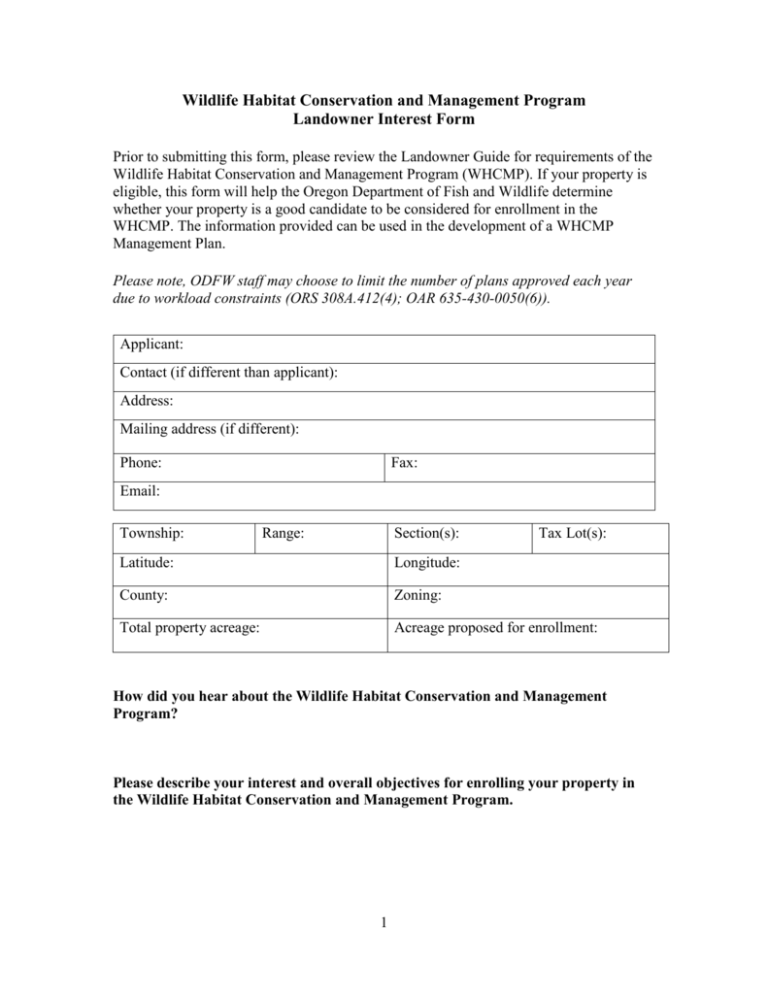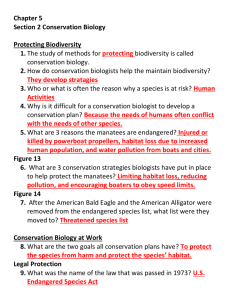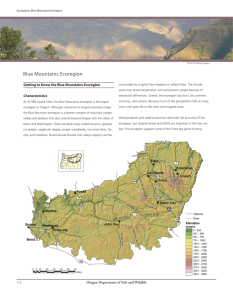Landowner Interest Form - Oregon Department of Fish and Wildlife
advertisement

Wildlife Habitat Conservation and Management Program Landowner Interest Form Prior to submitting this form, please review the Landowner Guide for requirements of the Wildlife Habitat Conservation and Management Program (WHCMP). If your property is eligible, this form will help the Oregon Department of Fish and Wildlife determine whether your property is a good candidate to be considered for enrollment in the WHCMP. The information provided can be used in the development of a WHCMP Management Plan. Please note, ODFW staff may choose to limit the number of plans approved each year due to workload constraints (ORS 308A.412(4); OAR 635-430-0050(6)). Applicant: Contact (if different than applicant): Address: Mailing address (if different): Phone: Fax: Email: Township: Range: Section(s): Tax Lot(s): Latitude: Longitude: County: Zoning: Total property acreage: Acreage proposed for enrollment: How did you hear about the Wildlife Habitat Conservation and Management Program? Please describe your interest and overall objectives for enrolling your property in the Wildlife Habitat Conservation and Management Program. 1 Has the proposed property been enrolled or is currently enrolled in other conservation programs (e.g., OWEB, CREP)? If yes, please provide more detail. Describe the property’s current use. Please include any physical structures such as residences, sheds, roads, and fences. Describe the use of the land surrounding the proposed property. Per OAR 635-430-0020, the objective of the WHCMP is to preserve, enhance or improve the composition, structure or function of habitat for native wildlife species. Please describe the native habitat(s) on the proposed property and how they meet one or more of the following using the table below: (1) Have been identified as scarce, becoming scarce, or of special ecological significance. Sources of information that may be used to identify these habitats include, but are not limited to, the Biodiversity Gap Analysis Program of the USGS Biological Resources Division and the Oregon Department of Fish and Wildlife, the Metropolitan Greenspaces Master Plan or equivalent Metropolitan Functional Plans, the Oregon Natural Heritage Program, the Oregon Biodiversity Project, the Oregon Habitat Joint Venture, the Oregon Comprehensive Wildlife Conservation Strategy, and the Oregon Plan for Salmon and Watersheds. (2) Have been identified by state or federal resource agencies, local governments, regional governments, watershed councils, conservation organizations or other qualified entities as important habitats for ecological restoration to prevent additional loss of native habitats or species. (3) Are important to achieve the conservation or management objectives for native habitats or species in public or private land management plans covering multiple land ownerships. (4) Provide habitat for threatened or endangered species listed in or pursuant to 16 USC Section 1533, ORS 496.172(2), and OAR 635-100-0125. (5) Provide habitat for state sensitive species listed in pursuant to OAR 635-1000040. (6) Are identified as significant wildlife habitat in the Goal 5 elements of city or county comprehensive plans. (7) Areas that have been adopted by the Metropolitan Service District (Metro) as significant natural areas, open spaces or fish and wildlife habitats or regional resources under Goal 5 pursuant to OAR 660-023-0080. 2 Identified Habitat Source of identification Existing (from numbered list acreage on above) property Acreage to be restored on property For each habitat type identified on your property, provide at least three conservation goals. Describe some of the wildlife observed on the proposed property. Are you aware of any threatened, endangered, or sensitive wildlife, fish, or plant species on the proposed property? If so, please list them. Is the property is located within a Conservation Opportunity Area as identified in the Oregon Conservation Strategy? If so, please provide the details below. 3 Identify any current or planned recreational activities that would occur on the property (e.g., off road vehicle, shooting range, wildlife viewing, hunting, events). Will herbicides be utilized for restoration activities or maintenance? If so, what products have been selected? If not, are you opposed to using herbicides for restoration activities or maintenance? Please list the species of any pets and/or livestock on the property. Do feral cats frequently roam the property? If so, approximately how many are there? Who will manage and/or monitor the property to comply with the WHCMP Management Plan? Describe the management entity’s capacity to implement the conservation and management practices necessary to restore and maintain the property. 4









